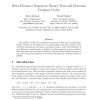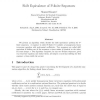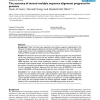BMCBI
2007
14 years 3 days ago
2007
Background: Protein remote homology detection is a central problem in computational biology. Most recent methods train support vector machines to discriminate between related and ...
BMCBI
2007
14 years 3 days ago
2007
Background: The post-genomic era is characterised by a torrent of biological information flooding the public databases. As a direct consequence, similarity searches starting with ...
COMBINATORICS
2006
14 years 4 days ago
2006
We consider a family of meta-Fibonacci sequences which arise in studying the number of leaves at the largest level in certain infinite sequences of binary trees, restricted compos...
COMBINATORICS
2006
14 years 4 days ago
2006
We present an algorithm which decides the shift equivalence problem for Pfinite sequences. A sequence is called P-finite if it satisfies a homogeneous linear recurrence equation w...
CANDC
2006
ACM
14 years 4 days ago
2006
ACM
DNA sequencing by hybridization (SBH) induces errors in the biochemical experiment. Some of them are random and disappear when the experiment is repeated. Others are systematic, i...
BMCBI
2006
14 years 4 days ago
2006
Background: The splicing of RNA transcripts is thought to be partly promoted and regulated by sequences embedded within exons. Known sequences include binding sites for SR protein...
BMCBI
2006
14 years 4 days ago
2006
Background: Algorithms that locate evolutionarily conserved sequences have become powerful tools for finding functional DNA elements, including transcription factor binding sites;...
BMCBI
2006
2006
A jumping profile Hidden Markov Model and applications to recombination sites in HIV and HCV genomes
14 years 4 days ago
Background: Jumping alignments have recently been proposed as a strategy to search a given multiple sequence alignment A against a database. Instead of comparing a database sequen...
BMCBI
2006
14 years 4 days ago
2006
Background: There have been many algorithms and software programs implemented for the inference of multiple sequence alignments of protein and DNA sequences. The "true" ...
BMCBI
2006
14 years 4 days ago
2006
Background: Genome sequences vary strongly in their repetitiveness and the causes for this are still debated. Here we propose a novel measure of genome repetitiveness, the index o...





